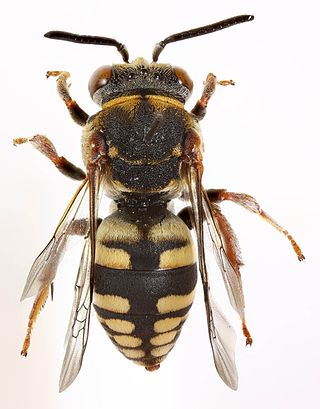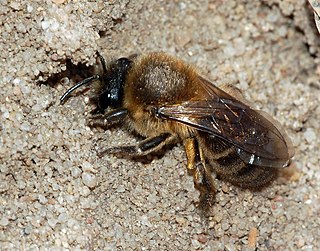
The genus Neomys is a group of four Eurasian water shrews from the subfamily Soricinae of the family Soricidae. These shrews are found in most of Europe and parts of northern Asia, as well as Turkey and Iran. Its member species are:

The Eurasian water shrew, known in the United Kingdom as the water shrew, is a relatively large shrew, up to 10 cm (4 in) long, with a tail up to three-quarters as long again. It has short, dark fur, often with a few white tufts, a white belly, and a few stiff hairs around the feet and tail. It lives close to fresh water, hunting aquatic prey in the water and nearby. Its fur traps bubbles of air in the water which greatly aids its buoyancy, but requires it to anchor itself to remain underwater for more than the briefest of dives.

Colletes inaequalis is a common species of plasterer bee, native to North America. Like other species in the genus, it builds cells in underground nests that are lined with a polyester secretion, earning the genus the nickname of polyester bees. C. inaequalis is a pollinator of red maple trees, willow trees, and apple trees.

The Colletidae are a family of bees, and are often referred to collectively as plasterer bees or polyester bees, due to the method of smoothing the walls of their nest cells with secretions applied with their mouthparts; these secretions dry into a cellophane-like lining. The five subfamilies, 54 genera, and over 2000 species are all evidently solitary, though many nest in aggregations. Two of the subfamilies, Euryglossinae and Hylaeinae, lack the external pollen-carrying apparatus that otherwise characterizes most bees, and instead carry the pollen in their crops. These groups, and most genera in this family, have liquid or semiliquid pollen masses on which the larvae develop.

The lowland burrowing tree frog or northern casquehead frog is a species of frog in the family Hylidae. It is found in south-central Arizona, the United States, and southward along the coastal plain and foothills to Western and South-Central Mexico. Its natural habitats are open mesquite grassland and tropical scrub forests at elevations from near sea level to about 1,490 m (4,890 ft) above sea level. It is a burrowing frog that is common in rain-filled temporary pools, its breeding habitat. It is threatened by habitat loss caused by agricultural development. However, many well-preserved populations have been recorded.

The genus Colletes is a large group of ground-nesting bees of the family Colletidae. They occur primarily in the Northern Hemisphere. They tend to be solitary, but sometimes nest close together in aggregations. Species in the genus build cells in underground nests that are lined with a cellophane-like plastic secretion, a true polyester, earning them the nickname polyester bees.

The northern colletes is a species of bee within the genus Colletes. Northern colletes are solitary bees, though females may nest in what are termed aggregations – sites where the bees nest close together, but do not form colonies as social bees do. They nest underground in soft soil, digging burrows up to 20 times their body length. It is often to be found nesting in coastal sand dunes and, on Hebridean islands, machair.

Nectogalini is a tribe of Old World water shrews within the family Soricidae. As of late 2007, it consisted of six extant genera and 25 species, with some of the latter being further divided into subspecies. Some, but not all members of the tribe are semiaquatic.
Colletes elegans a species of ground-nesting bee in the genus Colletes, which is found in Israel. It has been found that the species has a strong preference during pollination to plants in the family Resedaceae.

Colletes hederae, the ivy bee, is a species of plasterer bee belonging to the family Colletidae subfamily Colletinae.

Rhodocollybia fodiens is a species of fungus in the mushroom family Omphalotaceae.

Colletes halophilus, the sea aster mining bee, is a rare species of mining bee from the family Colletidae which is found around the margins of saltmarsh and other coastal habitats in south-eastern England and north-western Europe. It is threatened by rising sea levels and human development which reduce its food plant sea aster and destroy its nesting areas.

Colletes succinctus, the common colletes or heather colletes, is a species of Palearctic mining bee from the family Colletidae. It is part of the succinctus species group within the genus Colletes and is especially closely related to the ivy bee and the sea aster mining bee which are partially sympatric with C. succinctus but ecologically separate.

Epeolus cruciger, the red-thighed epeolus, is a species of cuckoo bee from the family Apidae. It is endemic to Europe, where its main host is the common colletes, although other species of Colletes mining bees have been recorded as hosts.

Colletes validus, colloquially known as the blueberry cellophane bee, is a solitary, specialist bee in the family Colletidae. It is found primarily in eastern North America where it nests in sandy soils near ericaceous plants.

Colletes solidaginis, the goldenrod cellophane bee, is a species of hymenopteran in the family Colletidae. It is found in North America.
Colletes longifacies is a species of hymenopteran in the family Colletidae. It is found in North America. The species is one of five from the family Colletidae that are endemic to the state of Florida. The species occurs in North-Central Peninsular Florida and the Panhandle.

Colletes cunicularius, the vernal colletes or spring mining bee, is a species of solitary bee from the family Colletidae which is widespread in the Palearctic from Britain to the Pacific Ocean which nests in areas of open, sandy soil.















